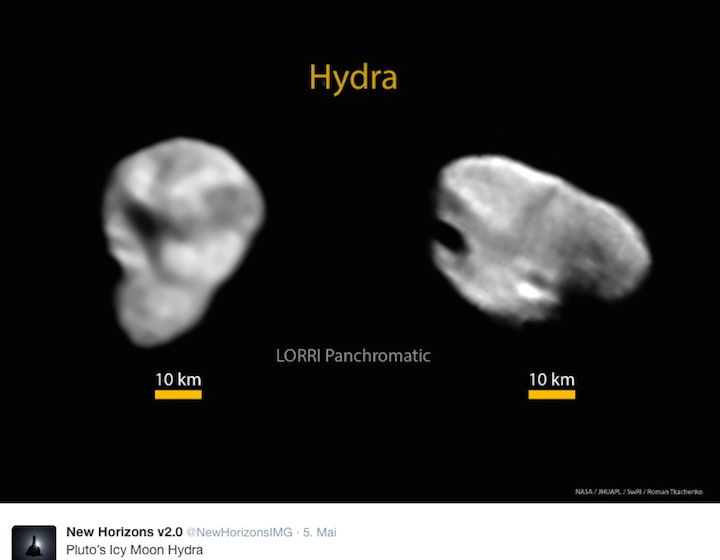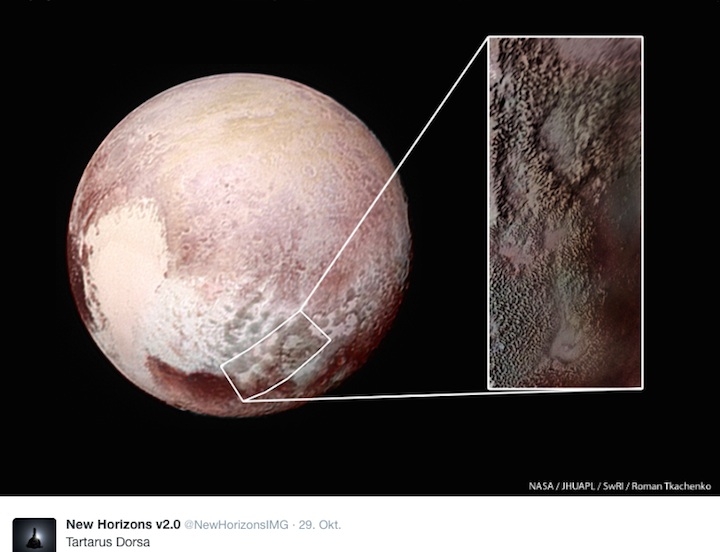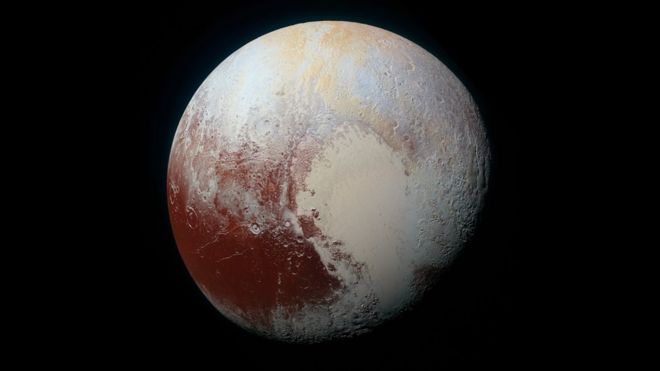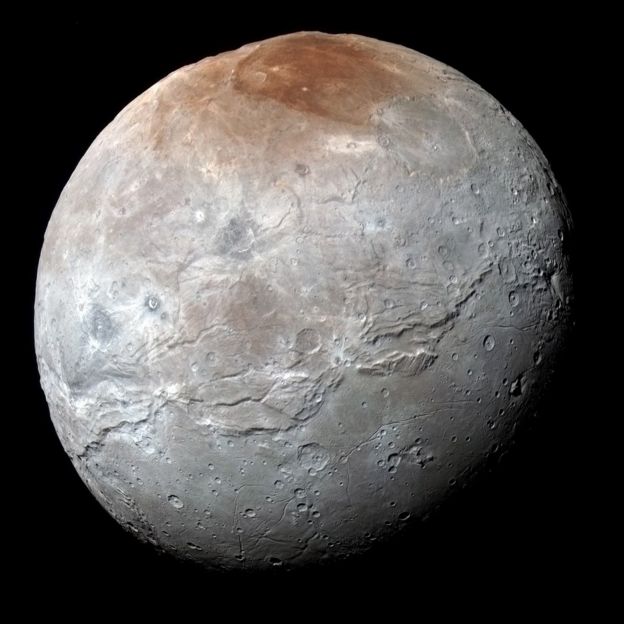.

Pluto is hazy, with a chance of clouds.
Scientists working with data from NASA’s New Horizons spacecraft, which flew past Pluto last year, are presenting some of their latest results this week in Pasadena, Calif., at a meeting of the American Astronomical Society’s Division for Planetary Sciences.
The findings include images showing seven small, bright spots that might be clouds floating just above Pluto’s surface.
.

New Horizons had already discovered haze in Pluto’s tenuous atmosphere, rising more than 120 miles into the sky and separated into at least 24 distinct layers.
“But hazes are not clouds,” S. Alan Stern, the principal investigator of New Horizons, said during a news conference on Tuesday.
Hazes spread out and do not block sunlight. If you were to stand on Pluto and look upward, its haze would filter only 2 percent of the light, Dr. Stern said. A cloud, on the other hand, is a puff that you cannot see through.
The crystal-clear images that New Horizons took during its flyby in July 2015 showed that Pluto was almost entirely cloud-free.
But careful sifting of high-resolution images revealed seven possible clouds, although Dr. Stern said there was no way to know for sure. All seven are bright features of similar size — on the order of miles — and all occurred near dawn or dusk, perhaps times when Plutonian clouds are more likely to form.
“We don’t see any decks or banks of clouds,” Dr. Stern said. “We see individual, discrete potential cloud features.”
Bonnie J. Buratti, an astronomer at the NASA Jet Propulsion Laboratory in Pasadena, also noted the widely ranging reflectivity of Pluto’s surface.
Regions near the Equator reflect just 8 percent of the sunlight, while places in Sputnik Planitia, the western half of the heart-shape feature on Pluto, are as bright as fresh snow.
Quelle: The New York Times
-
Update: 27.10.2016
.
NASA’s New Horizons mission reached a major milestone this week when the last bits of science data from the Pluto flyby – stored on the spacecraft’s digital recorders since July 2015 – arrived safely on Earth.
Having traveled from the New Horizons spacecraft over 3.4 billion miles, or 5.5 billion kilometers (five hours, eight minutes at light speed), the final item – a segment of a Pluto-Charon observation sequence taken by the Ralph/LEISA imager – arrived at mission operations at the Johns Hopkins Applied Physics Laboratory (APL) in Laurel, Maryland, at 5:48 a.m. EDT on Oct. 25. The downlink came via NASA’s Deep Space Network station in Canberra, Australia. It was the last of the 50-plus total gigabits of Pluto system data transmitted to Earth by New Horizons over the past 15 months.
“The Pluto system data that New Horizons collected has amazed us over and over again with the beauty and complexity of Pluto and its system of moons,” said Alan Stern, New Horizons principal investigator from Southwest Research Institute in Boulder, Colorado. “There’s a great deal of work ahead for us to understand the 400-plus scientific observations that have all been sent to Earth. And that’s exactly what we’re going to do—after all, who knows when the next data from a spacecraft visiting Pluto will be sent?”
Because it had only one shot at its target, New Horizons was designed to gather as much data as it could, as quickly as it could – taking about 100 times more data on close approach to Pluto and its moons than it could have sent home before flying onward. The spacecraft was programmed to send select, high-priority datasets home in the days just before and after close approach, and began returning the vast amount of remaining stored data in September 2015.
“We have our pot of gold,” said Mission Operations Manager Alice Bowman, of APL.
Bowman said the team will conduct a final data-verification review before erasing the two onboard recorders, and clearing space for new data to be taken during the New Horizons Kuiper Belt Extended Mission (KEM) that will include a series of distant Kuiper Belt object observations and a close encounter with a small Kuiper Belt object, 2014 MU69, on Jan. 1, 2019.
Quelle: NASA
-
Update: 28.10.2016
.
Pluto Exploration Complete:
New Horizons Returns Last Bits of 2015 Flyby Data to Earth
The Data Downlink Challenge
Why did it take more than a year for New Horizons to send back all of the data from the Pluto encounter? Take a minute to learn more about the challenge of sending data from over billions of miles.
NASA's New Horizons mission reached a major milestone this week when the last bits of science data from the Pluto flyby – stored on the spacecraft's digital recorders since July 2015 – arrived safely on Earth.
Having traveled from the New Horizons spacecraft over 3.1 billion miles (five hours, eight minutes at light speed), the final item – a segment of a Pluto-Charon observation sequence taken by the Ralph/LEISA imager – arrived at mission operations at the Johns Hopkins Applied Physics Laboratory (APL) in Laurel, Maryland, at 5:48 a.m. EDT on Oct. 25. The downlink came via NASA's Deep Space Network station in Canberra, Australia. It was the last of the 50-plus total gigabits of Pluto system data transmitted to Earth by New Horizons over the past 15 months.
"The Pluto system data that New Horizons collected has amazed us over and over again with the beauty and complexity of Pluto and its system of moons," said Alan Stern, New Horizons principal investigator from Southwest Research Institute in Boulder, Colorado. "There's a great deal of work ahead for us to understand the 400-plus scientific observations that have all been sent to Earth. And that's exactly what we're going to do—after all, who knows when the next data from a spacecraft visiting Pluto will be sent?"
Because it had only one shot at its target, New Horizons was designed to gather as much data as it could, as quickly as it could – taking about 100 times more data on close approach to Pluto and its moons than it could have sent home before flying onward. The spacecraft was programmed to send select, high-priority datasets home in the days just before and after close approach, and began returning the vast amount of remaining stored data in September 2015.
"We have our pot of gold," said Mission Operations Manager Alice Bowman, of APL.
Bowman said the team will conduct a final data-verification review before erasing the two onboard recorders, and clearing space for new data to be taken during the New Horizons Kuiper Belt Extended Mission (KEM) that will include a series of distant Kuiper Belt object observations and a close encounter with a small Kuiper Belt object, 2014 MU69, on Jan. 1, 2019.
Quelle: NASA
-
Update: 2.11.2016
.





Quelle: NASA
-
Update: 17.11.2016
.
Pluto 'has slushy ocean' below surface
 Image copyrightNASA/JHUAPL/SWRI
Image copyrightNASA/JHUAPL/SWRI
Pluto may harbour a slushy water ocean beneath its most prominent surface feature, known as the "heart".
This could explain why part of the heart-shaped region - called Sputnik Planitia - is locked in alignment with Pluto's largest moon Charon.
A viscous ocean beneath the icy crust could have acted as a heavy, irregular mass that rolled Pluto over, so that Sputnik Planitia was facing the moon.
The findings are based on data from Nasa's New Horizons spacecraft.
The space probe flew by the dwarf planet in July 2015 and is now headed into the Kuiper Belt, an icy region of the Solar System beyond Neptune's orbit.
Sputnik Planitia is a circular region in the heart's left "ventricle" and is aligned almost exactly opposite Charon. In addition, Pluto and Charon are tidally locked, which results in Pluto and Charon always showing the same face to each other.
 Image copyrightNASA/JHUAPL/SWRI
Image copyrightNASA/JHUAPL/SWRI
"If you were to draw a line from the centre of Pluto's moon Charon through Pluto, it would come out on the other side, almost right through Sputnik Planitia. That line is what we call the tidal axis" said James Keane, from the University of Arizona, co-author of one of a pair of papers published on the subject in Nature journal.
This is strongly suggestive of a particular evolutionary course for Pluto. The researchers contend that Sputnik Planitia formed somewhere else on Pluto and then dragged the entire dwarf planet over - by as much as 60 degrees - relative to its spin axis.
Slushy pup?
He explained: "If you have a perfectly spherical planet... and you stick a lump of extra mass on the side and let it spin, the planet will re-orient to move that extra mass closer to the equator. For bodies like Pluto that are tidally locked, it will move it toward that tidal axis - the one connecting Pluto and Charon."
Prof Francis Nimmo, from University of California, Santa Cruz, one of the authors of a separate study in Nature, told the BBC's Inside Science radio programme: "There's more mass in Sputnik Planitia than in surrounding regions - so somehow there's extra stuff there."
 Image copyrightNASA/JHUAPL/SWRI
Image copyrightNASA/JHUAPL/SWRI
But there's a problem with this idea, because the feature is thought to be the result of an impact with another object at some point in Pluto's past.
"Sputnik Planitia is a hole in the ground, so there shouldn't be more weight, there should be less weight. If the story is correct, you have to find some way of hiding extra mass underneath the surface of Sputnik Planitia," said Prof Nimmo.
"If you take some of the ice beneath Sputnik Planitia and replace it with water, water is denser than ice... so you'd be adding extra mass. That would help Sputnik Planitia to have more mass overall."
If a massive impact created the basin, it may have also triggered any material - such as a slushy ocean - beneath the surface to push Pluto's thin crust outward, causing a "positive gravitational anomaly" that would have caused the dwarf planet to roll over.
Prof Martin Siegert, from Imperial College London, who was not involved with either study, called the result "fascinating".
"The ocean would be incredibly cold, and hyper saline (I think they said enriched in ammonia), so unlike water on Earth or Europa," he told the BBC News Website.
"It would certainly be an extreme environment! Perhaps the most extreme in the Solar System?"
 Image copyrightNASA
Image copyrightNASA
But James Keane thinks phenomena other than a subsurface ocean could explain the alignment of Sputnik Planitia with Charon.
"Sputnik Planitia is filled with several kilometres of volatile ices. These ices are predominantly things that we think of as gases here on Earth - nitrogen, methane and carbon monoxide. On Pluto these are solid, and they behave almost like glaciers do on Earth," he said.
His team's explanation focuses on the nitrogen ice: "Each time Pluto goes around the Sun, a bit of nitrogen accumulates in the heart... once enough ice has piled up, maybe a hundred metres thick, it starts to overwhelm the planet's shape, which dictates the planet's orientation.
"If you have an excess of mass in one spot on the planet, it wants to go to the equator. Eventually, over millions of years, it will drag the whole planet over."
But he added: "It's hard to distinguish between either scenario, so both teams will have to do future work to try to test both hypotheses."
New Horizons, which is about the size of a baby grand piano, was launched on 14 January 2006 from Cape Canaveral in Florida. After its flyby of Pluto, mission scientists identified a second target - an icy Kuiper Belt body called 2014 MU69 - which the probe should reach in 2019.
Quelle: BBC
---
Pluto has a cold, wandering heart, and maybe a hidden ocean too

Scientists looking deep into the heart of Pluto have discovered more evidence that the dwarf planet could be hiding a liquid ocean beneath its icy surface.
In two papers published Wednesday in the journal Nature, researchers say Sputnik Planitia, the bright left lobe of Pluto’s “heart,” is on the move — slowly drifting toward the petite planet’s equator.
One possible explanation for this drift would be an ocean of water lying beneath the surface, the scientists said.
“It’s not a bulletproof argument, but so far, all the evidence points in the direction of an ocean,” said Francis Nimmo, a planetary scientist at UC Santa Cruz and the lead author of one of the papers.
Sputnik Planitia is a smooth basin about 600 miles in width. Measurements taken by NASA’s New Horizons spacecraft show that it is covered in bright nitrogen ice. Previous studies suggest that it was carved out when another body at least 125 miles across slammed into the dwarf planet’s surface long ago.
It is also in a particularly interesting spot on Pluto’s surface.
“We call it the tidal axis,” said James Keane, a graduate student at the University of Arizona and the first author of the other paper. “If you drew a line from the center of Pluto’s moon Charon through the center of Pluto and out the other side you would come very close to the location where Sputnik Planitia is today.”
Both research teams agree that the location of Sputnik Planitia is no accident: They say the mini-planet reoriented itself to make sure the formation ended up where it did in a process called “true polar wander.”
True polar wander occurs when a planet or mini-planet forms a new feature that changes its balance of mass. If one area suddenly has more mass, perhaps because an enormous volcano has erupted on that spot, the planet will reorient itself so the more massive feature is closer to the equator. If a part of the planet suddenly loses a lot of mass, that feature will drift toward the poles.
It’s not that the physical feature is moving across the surface, Keane said. Instead, the planet is reorienting itself on its axis. Picture an 8-ball in billiards, with the 8 facing you. Now imagine turning it slowly until the 8 is facing the floor.

The fact that Sputnik Planitia is near Pluto’s equator indicates that it has comparatively more mass than other parts of the dwarf planet, Keane said.
It’s a little counterintuitive, however, since Sputnik Planitia is essentially a giant hole in the ground.
To determine how the impact basin could still have enough mass to cause it to migrate to its telltale location, both teams turned to computer models to test different scenarios.
Keane’s group found that the depression could gain enough mass to cause true polar wander by a combination of two factors.
If most of the material ejected from the crater during the impact ultimately landed along the sides of the crater, and if a disproportionate of volatile ices like methane, nitrogen and carbon wind up in the impact basin due to seasonal snowfall, it’s possible for Sputnik Planitia to gain what’s called a positive mass anomaly, Keane said.
The other study came to a slightly different conclusion.
In that paper, Nimmo and his colleagues suggest that the positive mass anomaly was probably caused by a subsurface ocean that moved closer to the surface in the area of the impact crater.
Because liquid water is more dense than ice, the extra ocean in this part of Pluto would give Sputnik Planitia enough mass to explain its distinct location.
“If they are correct, that means the ocean still has to be there, because if it had turned to ice, it would be the same density as the rest of the crust,” Keane said.
Despite Pluto’s great distance from the sun, Nimmo said, it is entirely possible for it to have a liquid water ocean that endures to this day.
“Pluto has quite a lot of rock on its inside, and the radioactive elements in that rock could provide the heat,” he said.
In addition, the thick layer of ice on the dwarf planet’s surface would keep that heat from radiating out into the outer solar system.
“The radioactivity of the rock and the insulating blanket of ice could give Pluto a liquid ocean that can last for billions of years,” he said.
Brandon Johnson, a planetary scientist at Brown University who was not involved in either of the new studies, said the case for the reorientation of Pluto is a lot stronger thanks to the work of both teams.
He noted that Keane’s group used computer models to show that the pattern of cracks on Pluto’s surface could only occur if true polar wander had indeed taken place.
“That’s really a very convincing line of evidence that this true polar wander actually happened,” he said.
Johnson is inclined to agree with Nimmo’s group that Pluto has a subsurface ocean, but he said more work would need to be done before anyone can say that for certain.
“Somewhere down the pipeline there may be an analysis of another geological feature that either supports the subsurface ocean or argues against it,” he said. “But the current body of work supports an ocean more and more.”
Quelle: Los Angeles Times

